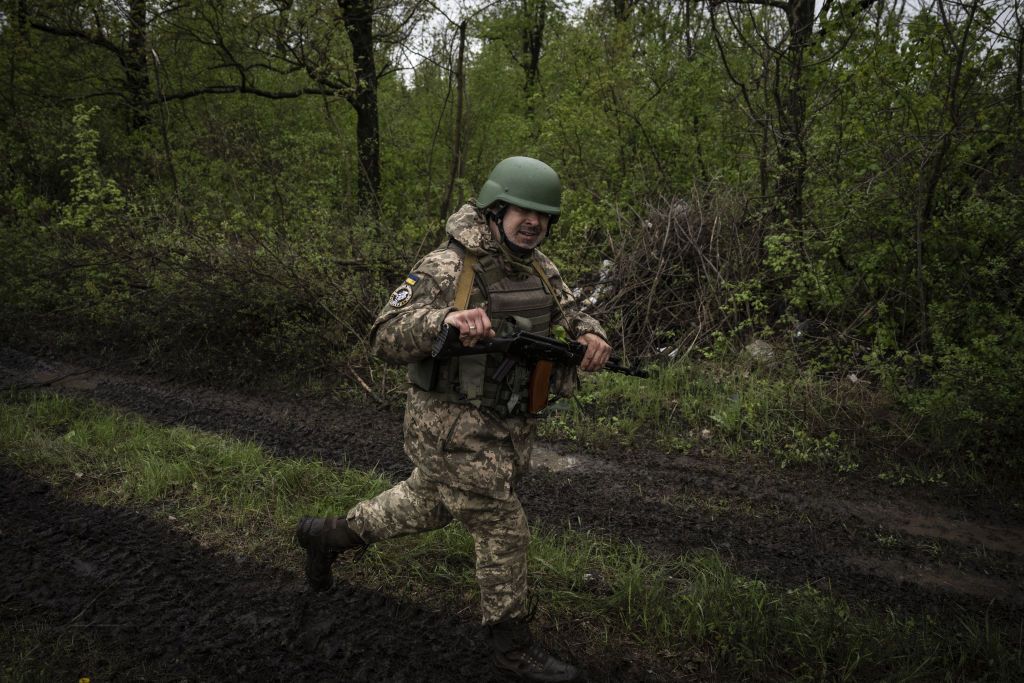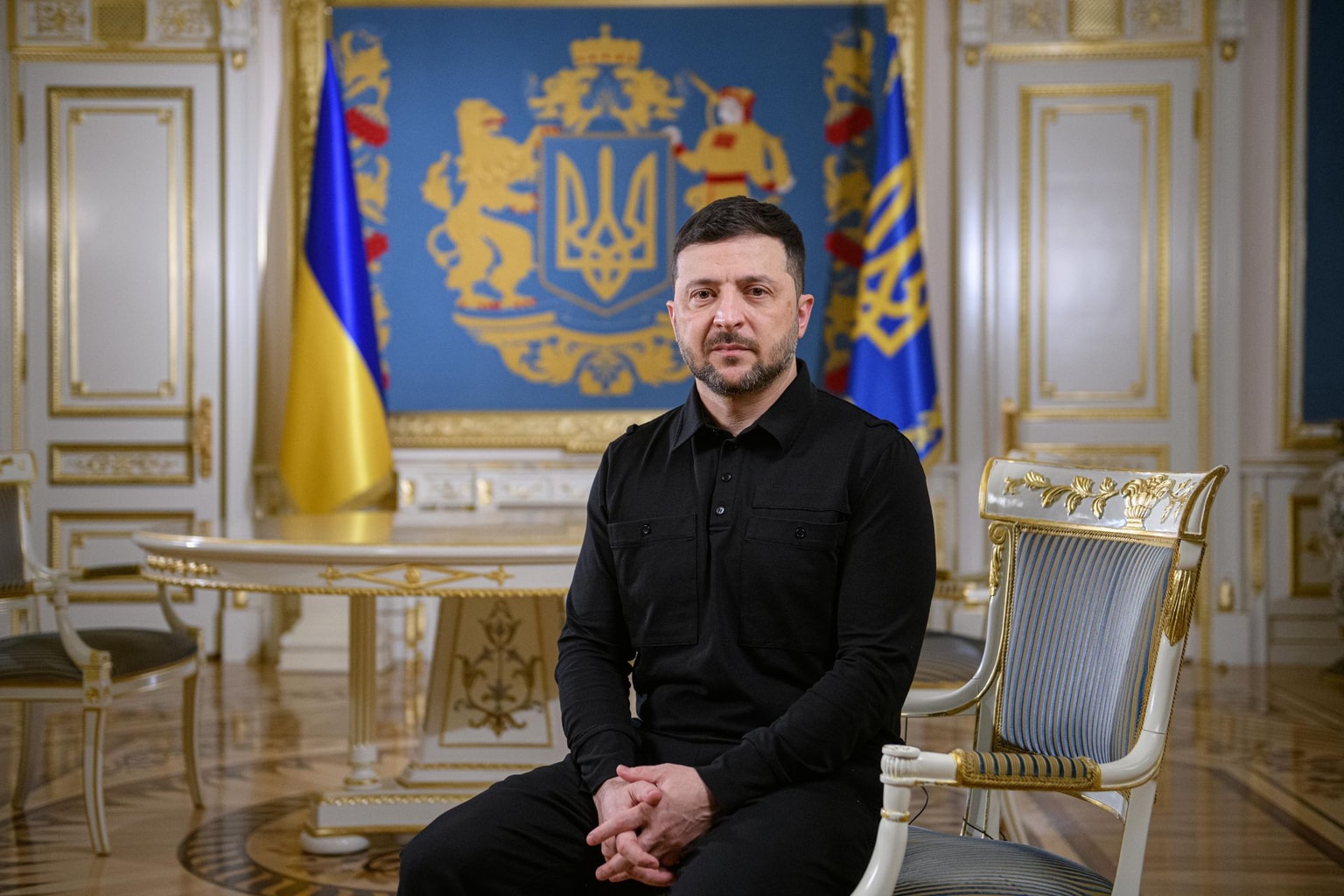Inside Ukraine’s costly mission to grind down Russia near Bakhmut

Editor’s note: The Kyiv Independent interviewed a few dozen soldiers deployed near Bakhmut and visited their positions in late May and early June. The soldiers are identified by their first names or call signs for security reasons amid the ongoing Russian war in Ukraine.
NEAR IVANIVSKE VILLAGE, Donetsk Oblast – Thuds of incoming artillery were loud as four senior servicemen from Ukraine’s 24th Assault Battalion (Aidar) walked through the mud to their dugout.
“Everything is being watched,” one of them said, asking the others to take shelter.
Russia’s reconnaissance drones are closely monitoring movements across the Bakhmut front, trying to locate Ukrainian positions like this dugout-turned-command center.
Ukraine responds by using drones of its own to spot Russian forces, passing coordinates to mortarmen a few kilometers away, set to destroy the Kremlin’s infantry.
“We watch streams provided by the drones and control our artillery, fire mortars, and make adjustments,” Denys, a 34-year-old lieutenant and mortar battery commander from Kyiv with the call sign “Lighthouse,” said once he entered the dugout.
Denys’ mortarmen are covering several defense lines of infantry deployed in front of them, with the furthest standing as close as 50 to 100 meters from the Russian forces.
After months of being on the defensive, Ukrainian forces are taking the initiative and conducting localized counterattacks on the flanks near Bakhmut.
Denys, who leads a team of up to 50 mortarmen deployed near Bakhmut since October 2022, is taking an active role in the fight.
Ukraine had more success south of Bakhmut, where more villages like the southwestern Ivanivske are located, rather than in the north – an open field where every movement is easily detected.
Though Bakhmut had fallen to Russia in May, Ukrainian soldiers believe the city served its goal – grinding down Russia’s offensive capability that it could otherwise use elsewhere.
They say that Russia concentrated its troop and equipment deployment to Bakhmut, which may have helped the Ukrainians launch a counteroffensive in the country’s southeast.
But the cost Ukraine paid to defend Bakhmut for so long was high.
Even if Russia’s losses were higher, several hundred Ukrainian soldiers were killed on the toughest days of the battle, according to soldiers’ accounts. They said some battalions, usually numbering between 400 to 1,000 soldiers, were wiped out.
Ukraine has not officially reported its casualties in the battle for Bakhmut, but it is expected to be staggeringly high.
According to the testimonies of soldiers from various brigades, thousands have lost their lives fighting for the city – with infantry taking the heaviest losses.
“It feels like a never-ending process, a scary game,” Denys said. His unit has been fighting here for eight months.
Defending Ivanivske
For Aidar Battalion Senior Sergeant Maksym, 32, and his comrade Oleksandr, 26, Russia’s destruction of Bakhmut is too familiar.
Their native cities, Lysychansk and Sievierodonetsk, which for months remained the last Ukrainian holdouts in Luhansk Oblast, suffered a similar fate before Russia captured them in July 2022.
After capturing Bakhmut using the same brutal siege tactic, the Ukrainians say the Russian forces are not attempting a major push in the area thus far.
Ukraine has for months strengthened its defense around Bakhmut, anticipating Russia’s eventual capture of the city, mortar battery commander Denys said.
The dugout near Bakhmut, for example, was also built during winter in anticipation of a retreat from the city, according to Maksym and Oleksandr.
The Aidar Battalion’s soldiers are deployed near Ivanivske, which sits on the road between Bakhmut and Chasiv Yar. The Russians must capture Ivanivske to advance toward Chasiv Yar – a hilly town that holds high grounds, which is advantageous for Ukrainian troops on the defensive.
Russian forces have been heavily bombarding Ivanivske and Chasiv Yar from high-rise buildings in southwestern Bakhmut, according to Denys. “(Chasiv Yar) is the next settlement, and they are already beating it very seriously, methodically razing it to the ground,” he said.
But no matter how hard the Russians are firing at them, the mortarmen need to keep working.

Maksym said it is scary because if anything happens to them, the infantry would be left without fire support.
“The guys in front of us won’t survive long without us, and we know we will not live long without them,” Maksym said. “Infantry is like a shield.”
Russian forces can jam radio connections, and mortars don’t always hit the target because they are subjected to weather conditions, making their task extremely difficult. Picking the right angle and coordinates is crucial.
Maksym said the “black and scary” humor with his comrades somehow keeps them going despite the hardships.
“There are no soldiers here, everyone has their own civilian profession, and we never wanted to fight,” Maksym said. “It’s not that we are brave; it’s just that someone broke into your house, and you are fighting back.”
Both Maksym and Oleksandr said they are fighting for their hometowns.
Oleksandr from occupied Sievierodonetsk said, “My goal in joining the army was so that I would end up in Sievierodonetsk.”

Grinding battles
The battle for Bakhmut has been the longest and the bloodiest phase of Russia’s war in Ukraine.
While the Ukrainian authorities have not confirmed it yet, Russia captured Bakhmut on May 20 when the Russian Defense Ministry and Wagner mercenaries claimed victory over the ruined city, according to Ukrainian soldiers and their commanders deployed in the area.
A 42-year-old Odesa-born mortar battery commander from the 58th Separate Motorized Infantry Brigade with a call sign “Lesnik,” also named Denys, believes holding on to Bakhmut was part of the counteroffensive.
Russia has likely become “less flexible in reacting to operational changes” after deploying its elite troops to Bakhmut, such as its airborne forces, according to the U.K. Defense Ministry’s June 3 intelligence report.
But all of it came at a significantly high cost.
Of the roughly 1,000 soldiers from his battalion deployed in Bakhmut since January, only about 100 were still active when they left in May to recover from the losses, Anatoly, a 56-year-old mortarman from the 93rd, said. The rest were either killed, wounded, or missing.
The 93rd is among the brigades that fought in the southwestern part of Bakhmut, near the now-destroyed MiG-17 aircraft monument.
This low-density residential area, where rows of single-family houses lined up, turned into a bloody battlefield because there were no tall buildings that could be used as hideouts, according to mortar battery commander Denys.
“If 20% of the personnel returned, it’s very good,” the mortar commander said.
Mykola, a soldier from the 57th Motorized Brigade, deployed near Chasiv Yar, only received a week of training after being drafted on March 29, but he said it didn’t matter. According to him, the only effective training can be done on the battlefield by more experienced soldiers.
Barely flinching at the thundering incoming and outgoing artillery shells over his head, Mykola said that the two months of fighting in and around Bakhmut were extremely brutal.
Since April, only eight out of the original 71 soldiers in his company remain in action, he explained.
A soldier from the western city of Chernivtsi who is deployed as a squad commander of an infantry unit based near Bakhmut, also called Denys, said he drank “water with blood” from a puddle as there was no other option.
Shocked at how many of his comrades were killed in the battle after returning from the front line, he said he worries if his superiors knew the extent of the brutality of the battle for the now destroyed and occupied city.
Not everyone can handle the stress on the front line, the soldiers also say.
For many soldiers, silence – which is rare on the front line – is uncomfortable, even far from the battlefield, because it usually meant that Russian forces were preparing for a major attack.
Vitaly, a 28-year-old mortarman from the 93rd brigade whose call sign is "Tarzan," struggles to sleep after his first combat mission near Bakhmut in May. He has the fear, even on his off days, that heavy artillery will kill him in his sleep.
Fighting for someone else
But no matter how horrifying their experience on the front line, the soldiers always say they were more worried about their comrades than themselves. Some of the strongest bonds are born in extremely harsh conditions.
In addition to all the stress the soldiers face to protect their comrades, as well as their own life, they are each going through their own personal battles that they try to keep to themselves.
For Vitaly from the 93rd, it’s talking with his mother as if he isn’t serving in the military. He said it hurts to lie to his mother, but he thinks it would be more painful to watch her nervously worry about him in western Volyn Oblast, especially after losing his father.
Anatoly, who takes care of Vitaly and other young soldiers in his platoon, can’t stop worrying about his younger son, aged 21, fighting near Kreminna – another hotspot of Russia’s war.
“I am ready to give my life for my son. I can die, but he must live,” Anatoly, the Dnipro-native soldier whose callsign is “Borman,” said.
Serhiy, a 43-year-old soldier from Chasiv Yar who lives with Anatoly and Vitaly, is worried he might never see his family again. He said it’s extremely painful to watch his hometown and Bakhmut, where he would often go shopping, turn to ruins.
"90% you will be killed here, 10% you will make it (till the end of the war)," Serhiy, who is eagerly waiting for his first combat mission so he can help end the war faster, said. "We can be alive today and not tomorrow."
______________________________________________________
Note from the author:
Hi, this is Asami Terajima, the author of this article.
Thank you for reading our story. It's always difficult to leave the Donbas after spending a lot of time with the soldiers, some of whom called me "a sister" after spending days together. I have met some of the best people in the Donbas, and it's painful knowing what they are enduring every day for future generations. But I was also touched by how the soldiers took care of each other, no matter how tough it is on the battlefield. To help the Kyiv Independent tell stories of Ukrainian soldiers that may otherwise be untold, please consider supporting us by becoming our patron.































